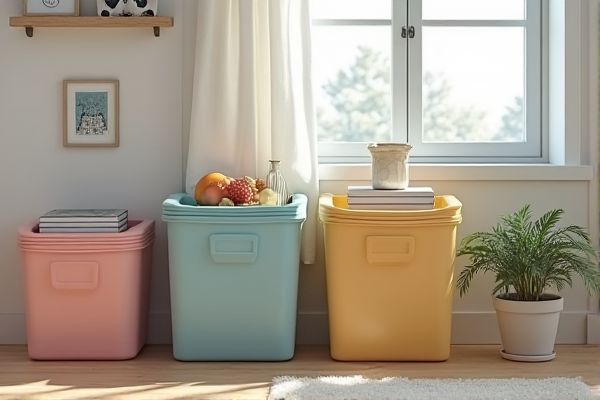
Stackable bins maximize vertical storage by securely fitting atop one another, saving space in warehouses or garages, while nested bins are designed to fit inside each other when empty, optimizing storage efficiency. Explore the rest of this article to understand which bin type best suits your organizational needs and storage goals.
Table of Comparison
| Feature | Stackable Bins | Nested Bins |
|---|---|---|
| Design | Flat bottom for stacking vertically | Tapered shape for nesting inside each other |
| Space Efficiency (Storage) | Requires more vertical space when full | Maximizes storage space by nesting empty bins |
| Convenience | Easy to stack and access contents | Reduces storage space when bins are empty |
| Durability | Sturdy, supports stacking weight | May be thinner to enable nesting, potentially less durable |
| Use Case | Ideal for fixed storage and organization | Best for transporting or storing empty bins efficiently |
| Cost | Generally higher due to heavier, sturdier build | Typically lower, lighter materials |
| Material | Heavy-duty plastic or metal | Lightweight plastic preferred |
Introduction to Stackable Bins and Nested Bins
Stackable bins are designed with flat tops and reinforced edges, allowing you to securely stack multiple bins vertically to maximize storage space efficiently. Nested bins feature tapered sides enabling one bin to fit inside another when empty, saving floor and shelf space during storage or transport. Choosing between stackable and nested bins depends on whether your priority is maximizing usable height or minimizing storage volume when not in use.
Understanding Stackable Bins
Stackable bins are designed with a reinforced structure and flat lids that support secure stacking, maximizing vertical storage space in warehouses or workshops. These bins improve organization and accessibility by allowing you to safely pile multiple units without crushing contents or compromising stability. Compared to nested bins, which save space when empty by fitting inside one another, stackable bins offer consistent usability whether full or empty, making them ideal for efficient inventory management.
Exploring Nested Bins
Nested bins offer space-saving advantages by fitting inside one another when empty, significantly reducing storage footprint compared to stackable bins. Their design enhances warehouse efficiency by optimizing shelf utilization and lowering transportation costs due to compact stacking. Ideal for industries with limited storage space, nested bins improve inventory management through streamlined stacking and accessibility.
Key Differences Between Stackable and Nested Bins
Stackable bins are designed with flat tops and reinforced edges to securely support the weight of bins placed above, optimizing vertical storage space. Nested bins feature tapered sides, allowing them to fit inside one another when empty, which saves floor space during storage or transport. The key differences lie in their space efficiency; stackable bins maximize storage volume when filled, while nested bins minimize footprint when empty.
Space Efficiency Comparison
Stackable bins maximize vertical space by securely stacking without nesting, allowing for easy access and organization. Nested bins save horizontal storage space by fitting one inside another when empty, ideal for compact storage needs. Your choice depends on whether you prioritize accessible storage with stackable options or space savings with nested designs.
Durability and Material Considerations
Stackable bins are typically made from rigid plastics like polypropylene, providing enhanced durability and resistance to impact, ideal for heavy-duty storage needs. Nested bins, often designed from thinner, more flexible materials, offer space-saving benefits but may compromise on strength and long-term wear resistance. Selecting materials with UV stabilization and reinforced edges further improves the longevity and durability of both stackable and nested bins.
Ease of Access and Handling
Stackable bins offer superior ease of access by allowing individual units to be removed without disturbing the entire stack, making them ideal for frequent retrieval tasks. Nested bins save space during storage by fitting inside one another but require unstacking to access lower bins, which can complicate handling. The choice depends on whether priority is given to efficient space utilization or quick, hassle-free access.
Cost Analysis: Stackable vs Nested Bins
Stackable bins typically incur higher upfront costs due to their reinforced structure designed for optimal vertical loading, whereas nested bins offer cost savings through reduced storage space requirements and lower material usage. Over time, stackable bins can improve operational efficiency by maximizing warehouse space and reducing handling time, potentially offsetting the initial investment. Nested bins, while cheaper initially, may increase labor costs in logistics since they require unstacking before use, influencing the overall cost-benefit analysis depending on specific warehouse workflows.
Best Applications for Stackable and Nested Bins
Stackable bins are ideal for maximizing vertical storage in warehouses with limited floor space, especially for heavy or uniform items that require easy access and stability. Nested bins are best suited for situations where space-saving during transport or storage of empty bins is critical, offering efficient nesting to reduce volume. Industries such as retail, automotive, and food processing benefit from stackable bins for sorting and inventory, while nested bins excel in logistics and distribution centers for cost-effective handling and storage.
Choosing the Right Bin for Your Storage Needs
Stackable bins maximize vertical space by securely stacking one on top of another, ideal for organizing items where height efficiency is crucial. Nested bins save floor space by fitting inside each other when empty, making them perfect for storing multiple bins compactly when not in use. Choosing the right bin depends on whether you prioritize ease of access and maximizing storage height or saving space during bin storage.
 homyna.com
homyna.com